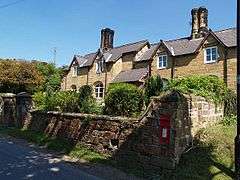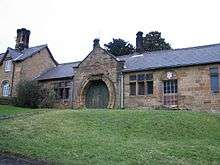Upsall
| Upsall | |
 Sandstone cottages in Upsall |
|
 Upsall |
|
| Population | 211 (Including Felixkirk , North Kilvington and Thornborough. 2011) |
|---|---|
| OS grid reference | SE453870 |
| District | Hambleton |
| Shire county | North Yorkshire |
| Region | Yorkshire and the Humber |
| Country | England |
| Sovereign state | United Kingdom |
| Post town | THIRSK |
| Postcode district | YO7 2 |
| Dialling code | 01845 |
| Police | North Yorkshire |
| Fire | North Yorkshire |
| Ambulance | Yorkshire |
| EU Parliament | Yorkshire and the Humber |
| UK Parliament | Thirsk and Malton |
Coordinates: 54°16′36″N 1°18′21″W / 54.27665°N 1.30582°W
Upsall is a hamlet in and civil parish in the Hambleton district of North Yorkshire, England. It is situated approximately four miles north-east of Thirsk. Upsall is part of the Upsall and Roxby estates owned by the Turton family. The village has a population of around 60 measured at 211 in the 2011 Census.[1]
History
The village is mentioned in two entries of the Domesday Book as Upsale in the Yarlestre hundred. Lands at the time of the Norman invasion were in the possession of Earl Waltheof, but soon passed to the Crown from whence it was granted to Count Robert of Mortain.[2] Some of the land was held for him by Richard of Soudeval. The lands passed to Robert de Mowbray, for whom the local Upsall family held the manor until 1327 when they were sold to Geoffrey Scrope. For a short while, the estates were Crown property before being granted to John Farnham in 1577. Thereafter, the lands passed through the Constable family to the Turtons in 1768.[3][4]
The name Upsall is thought to derive from the Viking Upsal-ir, meaning high dwellings or high halls.[3] The meaning is thus identical to one interpretation of Uppsala in Sweden.[5]
Governance
The village lies within Thirsk and Malton UK Parliament constituency. It also lies within the Thirsk electoral division of North Yorkshire County Council and the Whitestonecliffe ward of Hambleton District Council.[6]
Geography
The nearest settlements are Knayton 1.24 miles (2 km) to the north west; Kirby Knowle 1.1 miles (1.8 km) to the east and Felixkirk 1.66 miles (2.67 km) to the south.[6]
Upsall suffered from the North Yorkshire Floods in June 2005. Nine inches of rain fell on the village in about two hours on 19 June. The consequences of such exceptional rainfall were that crops were flattened, tarmac was stripped from the roads, private properties were flood-damaged, a bridge was destroyed and tons of earth were washed from the fields and deposited on the roads.
Upsall is home to a rare breed of cows called Upsall Polled Shorthorns. The herd was established in 1909 and narrowly escaped the 2001 outbreak of foot-and-mouth disease.[7]
The National Cycle Network route 65A (Yorkshire Moors & Coast) passes through Upsall village.[8]
Religion
A Wesleyan chapel was erected in the village in 1887, but is now disused.[3]
Notable buildings

Upsall Castle lies near the middle of the village. The 19th-century building was destroyed by fire in 1918 and rebuilt in 1922. The original Upsall castle dated from the 14th century, and was rebuilt by the Scrope family. The Legend of Upsall Castle is associated with the original castle.
Upsall has some notable architecture. The old forge, with the words Upsall Town and the date 1859 inscribed above its horseshoe arch, lies in the centre of the village.[9] Castle Farm is a Grade II listed structure and most of the buildings in Upsall are built from sandstone extracted from the old quarry. The abandoned Methodist chapel is one of the few brick-built buildings in Upsall.[10]
Nevison Hall is reputed to be the birthplace and sometime residence of the highwayman, Will Nevison, also known as Swift Nick.[3]
Folklore
Upsall is one of the many locations for The Man Who Became Rich through a Dream folk tale (Aarne-Thompson type 1645). The tale tells of an Upsall man who dreamed for several nights that if he stood on London Bridge he would hear good news. He travelled to the bridge and told his story to a Londoner, who laughed, saying that he had dreamed for several nights about buried treasure located in Upsall, Yorkshire. The Upsall man returned home, and found the treasure.[11]
References
- ↑ "Civil Parish population 2011". Neighbourhood Statistics. Office for National Statistics. Retrieved 2 August 2015.
- ↑ Upsall in the Domesday Book. Retrieved 31 December 2012.
- 1 2 3 4 Bulmer's Topography, History and Directory (Private and Commercial) of North Yorkshire 1890. S&N Publishing. 1890. p. 730. ISBN 1-86150-299-0.
- ↑ "History". Retrieved 31 December 2012.
- ↑ Reaney, P.H. (1960). The Origin of English Place Names. Routledge and Kegan Paul. p. 188.
- 1 2 Ordnance Survey Open Viewer
- ↑ "Rare Breeds". Retrieved 31 December 2012.
- ↑ "National Cycle Route 65A". Retrieved 31 December 2012.
- ↑ "Architecture". Retrieved 31 December 2012.
- ↑ "Listed Buildings". Retrieved 31 December 2012.
- ↑ Ashliman, D. L. "The Man Who Became Rich through a Dream: Folktales of Type 1645". University of Pittsburgh. Retrieved 27 August 2014.
External links
| Wikimedia Commons has media related to Upsall. |